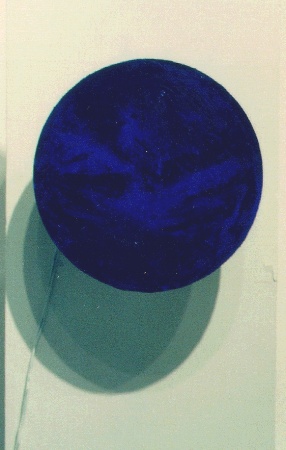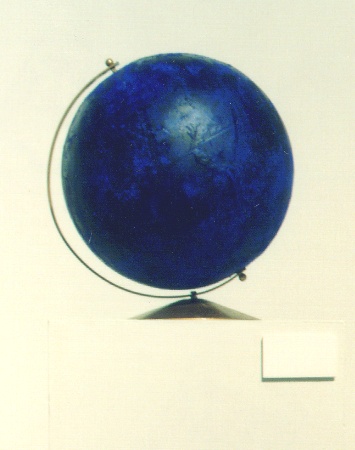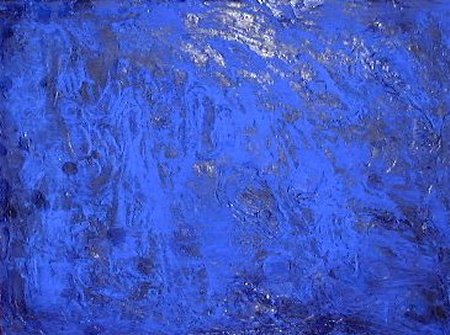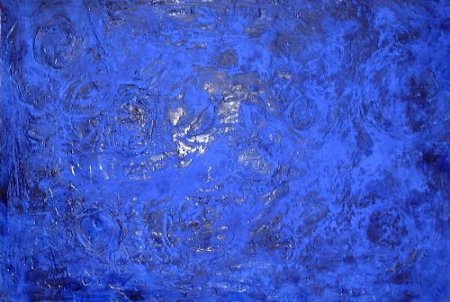| Back to show catalogue | ||
|
Klein & Tinguely - Phil Desmarais  Although Yves Klein's artistic career only lasted eight short years, from
1954 to 1962, he was a seminal figure of Pierre Restany's Le nouveau realisme.
Klein was one of the exceptional talents of the postwar period, whose early
death stopped a career still full of promises. Klein was a restless
and imaginative innovator with a genuine, original fantasy that lent authenticity
to his most outrageous displays. In 1958 he attracted many people
to an exhibition of nothingness, the void, bare walls that were offered
to the patrons to be paid for in gold. Klein's single coloured blue
paintings are the best known of his works. Klein adopted the monochromatic
aesthetic and the colour blue in order to remove all expressive and representative
elements from the work. Blue signified indefinableness and immaterialness.
Klein's work is often viewed as an attempt to reconcile life with art.
Klein's aim was to use art as a way of bringing people closer to life.
Life, as Klein saw it, was not at all something that man owned, but was
something that belonged to a higher order. In his beliefs it was
possible to gain possession of ones life, however, this could only happen
if your body was in touch with the cosmic. Klein did not restrict himself
to one medium, as his means of offerings an intimation of higher things,
but pondered at many different levels about techniques for achieving closer
being with the cosmic in everyday life. It is through this avenue
that he was able to work with other artists.
Although Yves Klein's artistic career only lasted eight short years, from
1954 to 1962, he was a seminal figure of Pierre Restany's Le nouveau realisme.
Klein was one of the exceptional talents of the postwar period, whose early
death stopped a career still full of promises. Klein was a restless
and imaginative innovator with a genuine, original fantasy that lent authenticity
to his most outrageous displays. In 1958 he attracted many people
to an exhibition of nothingness, the void, bare walls that were offered
to the patrons to be paid for in gold. Klein's single coloured blue
paintings are the best known of his works. Klein adopted the monochromatic
aesthetic and the colour blue in order to remove all expressive and representative
elements from the work. Blue signified indefinableness and immaterialness.
Klein's work is often viewed as an attempt to reconcile life with art.
Klein's aim was to use art as a way of bringing people closer to life.
Life, as Klein saw it, was not at all something that man owned, but was
something that belonged to a higher order. In his beliefs it was
possible to gain possession of ones life, however, this could only happen
if your body was in touch with the cosmic. Klein did not restrict himself
to one medium, as his means of offerings an intimation of higher things,
but pondered at many different levels about techniques for achieving closer
being with the cosmic in everyday life. It is through this avenue
that he was able to work with other artists.
Now that Klein decides that working with other artist is beneficial for
his pursued to achieve a higher conscious. Klein turns to Jean Tinguely
for collaboration in moving sculpture. Like Klein, Tinguely was also
apart of nouveau realisme, for Tinguely, mechanized motion is the medium
for creation of new art. After preliminary efforts and the formulation
of metamechanic reliefs and what he called "meta-matics", which exercised
the use of motion within a sculpture. Tinguely was so impressed by
the void room, that he felt that him and Klein shared a new outlook on
art and the world. The two soon became very good friends, and an
artistic collaboration followed. In November 1958, at the Gallery
of Iris Clert, Sheer Speed and Monochrone Stability was exhibited.
The effect of the objects in the show depended on a reciprocal amount of
paint support and mechanical apparatus, as in Space Centrifuge it was rendered
even more dramatic by blue sparks thrown off by the overheated motor beneath
the spinning disk. The idea that when the disk would spin the colour
would be so captivating that one would be emcompassed by the space of the
piece. The pieces were all made in Klein's mind to reflect a portion
of the void, and a tangible reality. The reasons for the disk go back to
his belief that the world is flat and that it is only through rotation
that it gives us the impression that it is a sphere.
Yves Klein was an artistic genius overflowing with possibilities and vitality,
a magician who turned everything upside down in the art world, by his touch
or his presence. Klein was a man that could make people believe that
everything in the world was art, and did so to an extent. Klein emphasized
that there was particular spiritual being to art. As Klein, rejected
the past in the way art was created, he sought a new way of creating a
new form of art production. By rebelling against conventional attitudes,
which threaten to restrict the concept of art. In which the art world
squeezed art into a rather confined definition, Klein exploded the narrow
concept of Modernism and paved the way for the future.
|
||
 In the joint projects to follow, Tinguely was responsible for conceiving
the space in terms of stasis of the speed, while Klein concentrated on
dissolution of colour by means of mechanically produced vibrations.
The disks ranged in size from nine centimeters to fifty centimeters in
diatmeter, and hwould rotate at a speed of either 450 turns per minute
all the way up to 10,000 turns per minute. The pieces activated the
small gallery with energy and stimulated all sorts of perceptual experiences
in its visitors. Theses objects brought the void concept and monochromes
into a tangiable existence. Many of their ideas never left the drawing
board. The next year, Klein, yet despite his longing for agreeable
company, continued to insist on staking out his own personal set of ideas
ended the collaboration with Tinguely.
In the joint projects to follow, Tinguely was responsible for conceiving
the space in terms of stasis of the speed, while Klein concentrated on
dissolution of colour by means of mechanically produced vibrations.
The disks ranged in size from nine centimeters to fifty centimeters in
diatmeter, and hwould rotate at a speed of either 450 turns per minute
all the way up to 10,000 turns per minute. The pieces activated the
small gallery with energy and stimulated all sorts of perceptual experiences
in its visitors. Theses objects brought the void concept and monochromes
into a tangiable existence. Many of their ideas never left the drawing
board. The next year, Klein, yet despite his longing for agreeable
company, continued to insist on staking out his own personal set of ideas
ended the collaboration with Tinguely.
 In trying to recreate the feel of what Yves Klein wanted, I must first
either accept him as a fraud or a genius. In my mind, his technical
ability was not perfect but his ideas were very avant garde. In this
writer's mind Yves Klein was no Charlatan, No one will ever know if he
would have turned into one though, cause he died so young, but his career
up to his death, he showed the art world many new things, even if they
were not paying attention. The final outcome is that if he were a
charlatan, we as a society and art students would not be studying him in
so much depth. But that is only the view of this writer. But the
problem with recreating his work is that, you must almost become him and
share his ideas, thus thinking you are creating something that will change
existence, but the fact that I merely fine many of his works challenging
in a technical manner, I'm only mimicking his style. The ideas are
what make his work, and I have neither the ego nor the outlook as he, to
create it in that way. Klein put so much energy in his work that,
I feel now that I'm doing an injustice to his work to reproduce it.
I enjoy the process of learning how his works were constructed, but in
fact many are not that difficult when thinking back. There are a
few works that I think would be very interesting to recreate, but "Complete
speed" is not one of them. All it took was a hobby motor, and a small disk
painted blue mounted on the axle of the motor. Sorry, I can't justify
writing 2 pages on that, nor can I on the "Planetary relief" or "Cosmogony".
The only thing I can say is that if Klein had not died and continued creating
art, I think the art world would be a very different place to be.
In trying to recreate the feel of what Yves Klein wanted, I must first
either accept him as a fraud or a genius. In my mind, his technical
ability was not perfect but his ideas were very avant garde. In this
writer's mind Yves Klein was no Charlatan, No one will ever know if he
would have turned into one though, cause he died so young, but his career
up to his death, he showed the art world many new things, even if they
were not paying attention. The final outcome is that if he were a
charlatan, we as a society and art students would not be studying him in
so much depth. But that is only the view of this writer. But the
problem with recreating his work is that, you must almost become him and
share his ideas, thus thinking you are creating something that will change
existence, but the fact that I merely fine many of his works challenging
in a technical manner, I'm only mimicking his style. The ideas are
what make his work, and I have neither the ego nor the outlook as he, to
create it in that way. Klein put so much energy in his work that,
I feel now that I'm doing an injustice to his work to reproduce it.
I enjoy the process of learning how his works were constructed, but in
fact many are not that difficult when thinking back. There are a
few works that I think would be very interesting to recreate, but "Complete
speed" is not one of them. All it took was a hobby motor, and a small disk
painted blue mounted on the axle of the motor. Sorry, I can't justify
writing 2 pages on that, nor can I on the "Planetary relief" or "Cosmogony".
The only thing I can say is that if Klein had not died and continued creating
art, I think the art world would be a very different place to be.
